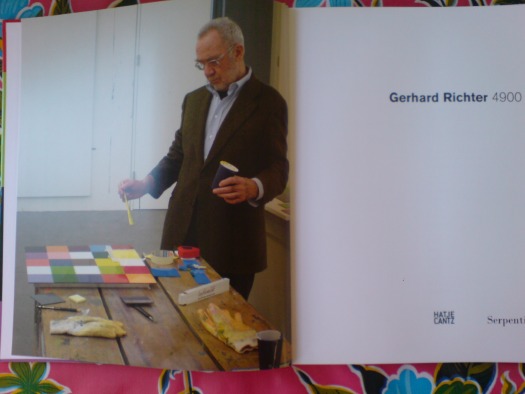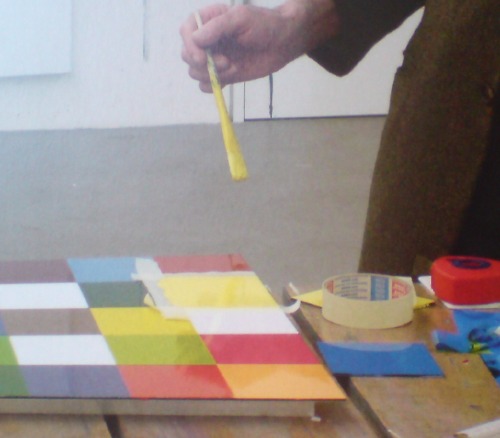
So my copy of the Serpentine Gallery's catalogue for "Gerhard Richter: 4900 Colours" finally came. This is the frontispiece, a photo by Joe Hage [who is turning up everywhere in Richterland now? He's the collector who's helping the artist with his evermore-info-intensive website. The staff of whom are also running the @gerhard-richter Twitter feed. He bought a half-interest in September, RIchter's little painting of the World Trade Center, which he and the artist donated to MoMA. And now he's hanging out with the artist as he puts the finishing touches on the 4900th colour? (It's tough when you start out on a parenthetical, only to end up with it as your main thought. Makes me want to just leave off the last bracket.)]
Anyway, my points--besides, "notice how sharply Mr. Richter is dressed for work"--are two, and somewhat inter-related:
He is painting with a brush and taping his edges. Enamel on aludibond, a European brand of aluminum composite panel. Not being any kind of painter, I've been slightly obsessed with what Benjamin Buchloh regularly calls facture, the technique for application of the paint. And frankly, I've been wary/nervous/feelin' like a cheater for thinking about taping my polygonal edges on my Dutch Landscape Paintings, for whatever reason.

So when I posted his 2001 quote to Michael Kimmelman this morning, before the book arrived, "Idiots can do what I do," I didn't think it would feel like such a personal invitation. "Thanks, I will!"
But now to the issue of Richter using tape and a brush. 4900 Colours is comprised of 196 48.5 sq. cm panels, each with 25 squares. That's [hold on, doing the math] 4900 squares--ah, right--in 25 colors. The colors were arranged on each panel following a randomizing computer program.
4900 Colours has 11 "Versions," which I believe refers to their possible configurations on the wall. Version I was all 196 in a single 49x49 square. The Serpentine showed Version II, 49 2x2 squares. And so on. The position and orientation of each panel is similarly determined in aleatory fashion. But as far as I understand it, there is only one set of 196 panels, not eleven. But even if there are not 1,960 additional panels that Richter had to paint with masking tape, a brush, a Dixie cup, and a fine tweed jacket, that's still a helluva lot of squares to paint.
Why that surprises me? I guess I just saw the vast, pixilated scale of this work, and the industrial luster of the panels themselves, and I assumed he had it fabricated. That the paint was mechanically applied. That he just hit ENTER on his random colorgrid generator app and exported the data file to a shop. That they glued the acrylic paint chips to the Aludibond, so mechanical and repetitive, an idiot could do it. And then a couple of weeks later, a truck backs up to his studio with all those gorgeous crates. It appears this was not the case at all, and that is really pretty stunning.
[But surely, this is not standard operating procedure? Is that how massive, repetitive/mechanical images like the electron microscopic photo mural made for the atrium of the De Young, made, too? Entirely by Richter's hand? Doesn't he have people for that? He's closing in on 80, I want him to have some people for that. See, here I am again with the parenthetical wrapup.
update: eh, bad example. The De Young's Strontium is made of C-prints.
update update: with encouragment from @manbartlett, I checked all 196 panels, and I can't find one with that color configuration. Which would mean it's a one-off or a study or a prototype. Whew.
Buy Gerhard Richter: 4900 Colours for around $43 at amazon [amazon]
Previously: What I looked at today - Gerhard Richter












